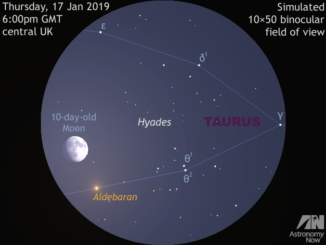
moon


See Mars, Uranus and the Moon get close on 10 February
Have you ever seen planet Uranus? If skies are clear in the UK and Western Europe on the evening of Sunday, 10 February, see this icy gas giant less than 2 degrees (or four lunar diameters) from Mars and 6 degrees from the 5-day-old crescent Moon. In fact, you’ll see all three in a single view of wide-angle binoculars like 7×50s.



See a dawn triple conjunction and a lunar occultation on 31 January
Skywatchers in the UK and Western Europe should look low to the south-southeast an hour before sunrise on 31 January to see a beautiful naked-eye conjunction of Venus, the old crescent Moon and Jupiter, all within a span of 8½ degrees. But if you have a telescope and live in just the right place, you can also see the Moon hide a double star.

The Moon invades the Hyades, close to bright star Aldebaran on 17 January
As dusk fades to dark on Thursday, 17 January, observers in the British Isles and Western Europe can see the rising 10-day-old Moon less than 1 degree away from first-magnitude star Aldebaran in the constellation of Taurus. Grab your binoculars to enjoy the sight of the gibbous Moon amid the Hyades open star cluster too.

See the Moon meet the Red Planet at dusk on 12 January 2019
Observers should direct their gaze to the southern sky at dusk on Saturday, 12 January to view the 6-day-old waxing Moon in the constellation of Pisces. Look a little closer around 6pm GMT in the UK this night to see Mars as a magnitude +0.6 orange-coloured ‘star’ above the lunar crescent. If you own wide-angle 7× or 8× binoculars, you can see the Moon and Red Planet in the same field of view.

See the old Moon close to Venus then Jupiter in the dawn sky
Early risers in the UK with an unobstructed horizon from southeast through south can see the old crescent Moon close to dazzling Venus in Libra then Jupiter in Ophiuchus over three consecutive mornings starting New Year’s Day around 7am GMT. The brightest and largest planets lie little more than the span of an outstretched hand at arm’s length apart at this time.

See the Moon get close to Mars on 18 October
Skywatchers in Western Europe looking in the southern sky at dusk on Thursday, 18 October can see the 9-day-old waxing gibbous Moon close to the upper left of Mars, the pair fitting comfortably in the same field of view of typical binoculars. This is also a good night for spotting some prominent martian features telescopically – seeing permitting!

